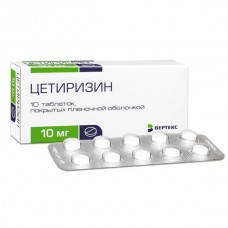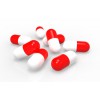Expiration date: 06/2026
Pharmacological action
Cetirizine - competitive antagonist of histamine, a metabolite gidroxizina, blocks H1-histamine receptors. Warn development and facilitates the allergic reactions, has antipruritic and protivoekssoudative action. Affects early stage of allergic reactions, restricts the release of mediators of inflammation at the late stage allergic reactions, reduces migration of eosinophils, neutrophils and basophils. Reduces the permeability of capillaries, prevents the development of tissue edema, relieves spasms of smooth muscles.
straney skin reaction to the introduction of histamine, specific allergens, as well as cooling (in cold urticaria).
Also has anticholinergic and antiserotonin action. In therapeutic doses practically does not cause sedation. The onset of action after a single ingestion of 10 mg cetirizine - 20 minutes (50% of patients) and 60 minutes (95% of patients), continues for more than 24 hours. Amid the course of treatment, tolerance to the antihistaminic action of cetirizine does not develop. After discontinuation of the treatment effect persisted up to 3 days.
Pharmacokinetics
Rapidly absorbed from the gastrointestinal tract, the time to reach Cmax after oral - 1 hour. Food does not affect the completeness of absorption (AUC), but lengthens 1 hour the time to reach Cmax and reduces the amount Cmax by 23%. When taken in a dose of 10 mg 1 times/day for 10 days equilibrium concentration in plasma is 310 ng/ml and observed after 0.5-1.5 hours after ingestion. Connection with plasma proteins is 93% and does not change when the concentration of cetirizine in the range of 25-1000 ng/ml. Pharmacokinetic parameters of cetirizine vary linearly with the dose of 5-60 mg. Vd - 0.5 l/kg. In small quantities metabolised in the liver by O-dezalkilirovania with the formation of pharmacologically inactive metabolite (unlike other blockers H1-histamine receptors, metabolized in the liver involving cytochrome P450). Not koumouliruet. 2/3 of the drug is excreted unchanged by the kidneys and about 10% - through the intestines.
Systemic clearance of 53 ml/minute. T1/2 in adults is 7-10 hours, children 6-12 years - 6 hours in children 2-6 years - 5 hours in children from 6 months to 2 years - 3 hours. In elderly patients T1/2 increased by 50%, systemic clearance is reduced by 40% (loss of kidney function).
In patients with impaired renal function (creatinine clearance below 40 ml/min) clearance of the drug decreases and T1/2 longer (for example, patients on hemodialysis, the total clearance is reduced by 70% and is 0.3 ml/min/kg and T1/2 longer 3 times) that requires a corresponding change of dosing regimen.
In patients with chronic liver diseases (hepatocellular, cholestatic or biliary cirrhosis), there is a lengthening of T1/2 by 50% and decreased total clearance is 40% (the correction mode is required only if it is accompanied by decrease in glomerular filtration rate). Passes into breast milk.
Testimony
- seasonal and year-round allergic rhinitis and conjunctivitis (itching, sneezing, rhinorrhea, lacrimation, conjunctival hyperemia);
- urticaria (including chronic idiopathic urticaria);
- hay fever (pollinosis);
- itching;
- angioedema (angioedema);
- itchy allergic dermatitis.
Contraindications
- reduced renal function (creatinine clearance 30-49 ml/min);
- chronic renal failure;
- children up to age 6 years;
- pregnancy;
- lactation;
- hypersensitivity to cetirizine, other components of the drug, hidroxizina.
With caution: advanced age (may decrease glomerular filtration).
Application of pregnancy and breastfeeding
Contraindicated during pregnancy and lactation.
Special instructions
Not recommended simultaneous use of alcohol and drugs, depressing the Central nervous system.
Effects on ability to drive vehicles and management mechanisms:
During treatment should refrain from activities potentially hazardous activities, require high concentration and psychomotor speed reactions. When the dose 10 mg/day the ability to make quick reactions may deteriorate.
Composition
1 tablet, film-coated, contains:
active substance: cetirizine dihydrochloride 10 mg;
excipients: cellulose microcrystalline, lactose monohydrate, crospovidone, magnesium stearate, silicon dioxide colloidal.
the composition of the shell: [hypromellose, talc, titanium dioxide, macrogol 4000] or [shell film a dry white containing hypromellose, talc, titanium dioxide, macrogol 4000].
Method of application and doses
Inside pills washed down with 200 ml of water, drops before taking dissolved in water.
Adults and children over 6 years - 10 mg 1 time per day or 5 mg 2 times a day
children 2-6 years - 5 mg 1 time per day, or 2.5 mg 2 times a day children 1-2 years - 2.5 mg (5 capsules) 2 times a day.
In patients with decreased renal function (CC 30-49 ml/min) administered 5 mg/day, in severe CRF (QC 10-30 ml/min) is 5 mg/day every other day.
Side effects
The drug Cetirizine is usually well tolerated. Side effects occur rarely and are transient in nature.
From the digestive system: dry mouth, dyspepsia.
From the nervous system: dizziness, headache, drowsiness, fatigue, agitation, headache.
Allergic reactions: angioedema, skin rashes, itching, hives.
Drug interactions
Simultaneous use with theophylline (400 mg/day) leads to a decrease in total clearance of cetirizine (kinetics of theophylline is not changed).
Myelotoxic drugs increase symptoms of hepatoxicity of the drug.
Not detected clinically significant interactions with other drugs (pseudoephedrine, cimetidine, ketoconazole, erythromycin, azithromycin, diazepam, glipizide).
Overdose
Symptoms: the drug a single dose of over 50 mg may be accompanied by signs of intoxication such as drowsiness, anxiety and increased irritability, possible signs of anticholinergic activities of urinary retention, dry mouth, constipation.
Treatment: induce vomiting, gastric lavage, taking activated charcoal immediately consult a doctor.
There is no specific antidote. Hemodialysis is ineffective.




